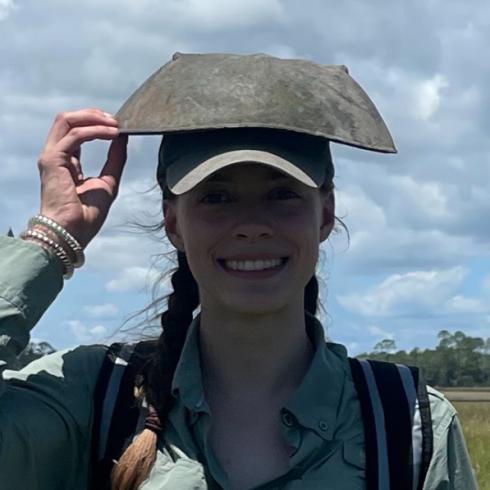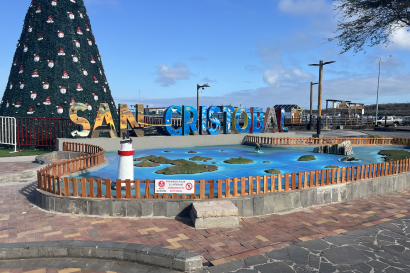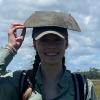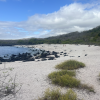The Galápagos Islands are often described as a living laboratory, a place where evolution plays out in real time. During my time studying abroad, I had the incredible opportunity to witness some of the most fascinating and unique wildlife in the world. What struck me the most wasn't just how different these creatures were from anything I'd seen before, but how they seemed to embody the essence of adaptation, survival, and resilience. From the shores to the skies, each encounter was a reminder of nature's boundless creativity. In this post, I’ll take you on a journey through the islands, sharing stories of 14 extraordinary species that made my experience truly unforgettable.
- The Blue-footed Booby, with its iconic blue feet, is a symbol of the Galápagos Islands. These striking feet help attract mates, while their impressive diving skills allow them to plunge into the water with precision in search of food. This picture was taken on Española Island but the Booby can also be found on San Cristobal Island, where we stayed for the majority of the program!

- The Galápagos Giant Tortoises are the gentle giants of the island. Known for their immense size and long lifespan, they can live over 100 years. Their unique dome-shaped shells and slow movements have helped them adapt to the diverse environments across the archipelago, making them a true symbol of evolution. We have spotted these tortoises in the wild on San Cristobal and Santa Cruz Islands, and have also visited the breeding centers on both islands!

- The Galápagos Sea Lions are playful and social, often seen lounging on beaches or swimming in the clear waters. Known for their agility in the water and relaxed demeanor on land, they are one of the archipelago’s most iconic species. We have swam with them in multiple locations around the island, but see them most often on Playa Mann and Playa Los Lobos on San Cristobal Island. This picture was taken on Playa Mann and is of two sea lion pups!

- The Marine Iguanas are the only iguanas that swim, diving for algae in the ocean. Their dark skin helps them absorb heat, allowing them to warm up quickly after foraging in the cool waters. Most of the islands have their own species, or subspecies, of Marine Iguanas.

- The Sally Lightfoot Crabs are colorful, fast-moving crabs found along the Galápagos coast. Their bright red color makes them easily recognizable as they scurry across rocks in search of food. When young, they are black/dark blue in color to disguise themselves from predators.

- The Galapagos Hawks are bold and curious birds, known for their keen hunting skills. As the top predators on the islands, they hunt a variety of prey, from small reptiles to insects. This hawk was spotted on Española Island.

- The Galapagos Mockingbirds are curious and adaptable, known for mimicking sounds from other species and their surroundings. They are different subspecies around the islands, including the San Cristobal Mockingbird.

- The Lava Lizards are small, colorful reptiles known for their territorial displays. Found across the islands, they thrive in volcanic landscapes, basking on rocks and hunting insects. Each island has their own species of these lizards!

- The Waved Albatrosses are large seabirds known for their exceptional ability to travel long-distance, spending much of their lives soaring over the open ocean before returning to the islands to breed. These birds were found in large quantities on Española Island.

- The Nazca Boobies are seabirds with distinctive black-and-white plumage and bright blue beaks. They are known for their graceful, coordinated hunting style and strong nesting habits. They can be found on a few different islands but these ones were spotted on Isabela Island.

- The Smooth-billed Anis are social, black birds known for their curved bills. Often seen in groups, they forage and thrive in various habitats across the Galapagos.

- The Galapagos Penguins are the only penguin species that live north of the equator. They thrive in the cooler waters of the islands around Isabela and are often found swimming and hunting for fish.
- The Galapagos Carpenter Bees are large, solitary bees known for their ability to tunnel into wood. These native pollinators play a crucial role in the island’s ecosystem by pollinating a variety of plants. The one pictured is a male, distinguishable by its yellow hair. Females are normally black in color.

- The Yellow-crowned Night Heron and Striated Heron are both found in the Galápagos, known for their hunting skills. The Night Heron, with its yellow crown, feeds at night, while the Striated Heron, with streaked plumage, hunts during the day. Out of the two, I saw the Yellow-crowned Night Heron more often and I was drawn to its mysterious presence, but my heart was softened by its shyness.



Faith Yost
Hi! I'm from Pennsylvania and I've always wanted to travel the world while sharing my experiences with others! I love being outdoors, including hiking, camping, or going to the beach. I'm excited to explore the natural world and culture in Ecuador!








